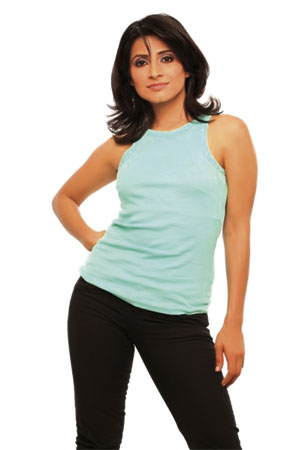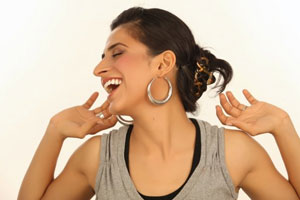Interview: Joshinder Chaggar
By Shimaila Matri Dawood | Arts & Culture | People | Q & A | Published 16 years ago
“Dance is not just about steps or moving the body. It’s a complete connection of the heart, the soul and the body”
– Joshinder Chaggar
A body stretches, reaching out to the sky. Hips thrust in an exaggerated spasm, palms extended, fingers pointing straight and knees only slightly bent. She leaps, steps, leaps again, and a one two three four, Joshinder Chaggar is off her feet again and pirouetting in the air.
A group of uncoordinated but eager young men and women try to follow Chaggar’s lead — desperately trying to ape her fluid and effortless movements — but collapse in uncoordinated heaps before bursting out into uncontrollable giggles. It is Josh (as she is more commonly known) herself that sets them off, before chiding the students, gathered at her biweekly Bollywood dancing class, “That was just terrr-ible guys!”
Known best for her appearances in Zeb and Haniya’s 2008 video ‘Aitebar,’ and Jal’s ‘Morey Piya,’ Joshinder Chaggar has not only danced for many high-profile artistes but also has notched up a notable number of prestigious TV slots as a dancer and choreographer, such as the 2007 Pakistan Style Awards, Geo’s 2008 Meri Adhoori Mohabbat grand finale show, and more recently, the PTV Style Awards 2009 and the Sohail Rana Tribute. She has also choreographed and performed at an event by style icon Tariq Amin, choreographed commercials for Telenor, Jazz, Tarang, Pakola milk and Amanat Ali’s music video ‘Kohram.’
And if her local resume is not impressive enough, Josh, who grew up in a small town just outside of Melbourne, has also released a Get Fit with Bollywood dance DVD in Australia in November 2006, which retails at outlets like HMV and Borders. As a special bonus for all her Bollywood dancing students, she has also danced in the Bollywood hit Heyy Baby, shot in Sydney in 2007.
If you want to catch this nimble young dancer in action, Josh is soon to direct, choreograph and dance in a contemporary dance show, Conversations.
Newsline talks to Josh about her influences, her favourite music, how she met her husband Khalid Malik (an actor and popular host of CityFM 89’s breakfast show), the couple’s move to Pakistan and, of course, all the latest on Josh’s upcoming production.
 Your life history sounds like a case study of a globalised child. You were born in India, moved to Nigeria when you were three, and then moved to Geelong, Australia in 1990. Did you receive dance training in all these countries?
Your life history sounds like a case study of a globalised child. You were born in India, moved to Nigeria when you were three, and then moved to Geelong, Australia in 1990. Did you receive dance training in all these countries?
Yes. I was born in Faridabad, but moved to Nigeria with my parents when I was three years old. There is a very large Indian community in Lagos, so my brother and I went to a private Indian school there. Dance was a subject at school, and we were taught basic Kathak and lots of folk dance. I started learning Bharata Natyam when I was five. The teacher left the country after I had been training for three years and the academy shut down. Learning that type of discipline at such a young age was very beneficial. In fact, the training I received there is something I draw on to this day.
In 1990 our family migrated to Geelong, just outside Melbourne, Australia. I studied dance as a subject in high school — mainly jazz. A few years later, I moved to Melbourne where I enrolled at university, and found another brilliant Bharata Natyam Academy, where I restarted my training. As a form of dance, Bharata Natyam is my first love. I love the strength and sharpness it demands.
I also undertook a one-year, full-time contemporary dance course at Deakin University in Melbourne. That was my first introduction to contemporary dance and I totally fell in love with it since it’s such an expressive form of dance.
Australia is very multicultural and that is reflected in their food, fashion and the thriving dance industry. Bollywood is hugely popular there. When I moved to Sydney, I joined the Melange Dance Company, where I trained with a group of girls from Brazil, Cuba, Africa and Sri Lanka. We trained in each other’s dance styles and performed amazing fusion dances all over Sydney. That was a really fun time and a massive learning curve for me.
Having worked in so many styles, fusion is a big part of my work. I love storytelling and exploring emotions through the body. The physical moves could draw influences from anywhere.
Why did you move to Pakistan? Did you find it easy to get dancing jobs here?
Khalid and I are both actors/performers (he received his training in Melbourne) and we basically heard about the media boom in Karachi. We were here on holiday visiting Khalid’s relatives and simply thought, why not? This is the age to travel and explore. So Khalid came first and I followed a month later. And to be honest, I didn’t have a clue what I was going to do here. I didn’t know much about Pakistan or its media industry.
But I’ve been very lucky. Khalid started working for MTV immediately, so I was called into MTV on my second day in Karachi to discuss choreographing the Pakistan Style awards. I was hired that day, and the day after I was hosting a show.
Saqib Malik, the director of Zeb and Haniya’s ‘Aitebar,’ saw me perform at these awards. I believe that’s what inspired him to offer me the music video. After the awards though, things slowed down. And I felt a bit confused about which direction to head in. I was offered to host a dance show on TV, but I didn’t feel I wanted to go in that direction. Then a friend suggested I go to NAPA, where I started teaching movement. I really loved the interaction with the students there.
Is that how the Bollywood dance classes came about?
Apart from teaching at NAPA, I wasn’t really interested in doing any other classes. But people here really love to dance and, sadly, there just aren’t enough teachers around. So, after being pestered for a year, I finally started my ‘Get Fit with Bollywood’ dance classes at ActOne in January 2009. And I’m so glad I did. They were an instant hit, and I usually have a waiting list of about 50 people for my evening classes.
The great thing is that I get my own workout, and I have met so many people through the classes and made some close friends that Karachi is starting to feel like home. It’s always about the people, isn’t it?
 Do you like living here?
Do you like living here?
Living in Karachi is so interesting and filled with so many contradictions. I’ve never felt this level of gratitude for having basic luxuries of water and electricity. Being here makes me question my existence and purpose in life a lot more. Also, teaching here is very intense. Some of my students tell me they have waited 10 years for a contemporary dance teacher. So when they come to class, they bring with them all this pent-up energy that is bursting to come out. I’ve never seen that before. It’s actually very rewarding to make someone lose their inhibitions and to actually follow the beat.
What motivates you to dance?
Dance is my first love. Before I analysed it, or it became my profession, it was just an obsession. I was always dancing. Also, I’m a very emotional and expressive dancer, so I get really carried away with the mood of the music. It’s not just about steps or moving the body. It’s a complete connection of the heart, the soul and the body.
What’s your favourite form of dance?
I love classical dance. I’m actually planning on continuing with some form of classical training.
Which dancers do you like to work with?
I really love working with the local dancers. Three dancers, Shaan Shaikh, Ghani and Shezy, who are also in my upcoming production, are among my favourites. I’ve worked with them in almost all my projects from the beginning. Ghani and Shezy used to be part of the Sonu Dangerous team and they’ve really created a bit of a name for themselves. So I’m really excited to have them onboard.
I think the rise in the number of dancers, choreographers, dance shows and musicals is fantastic. The more of us there are, the more people will open up to dance, which will increase demand and create bigger opportunities for all of us.
What is your upcoming show, Conversations, all about?
It’s a 60-minute contemporary dance/drama. I’ve been thinking about putting up a show for quite some time, and am glad that I’ve finally found the courage to do it.
The initial inspiration for the show was to explore movement and to do something very experimental. After working in so many commercial projects, one really craves the freedom a creative project allows.
I only had a rough idea of what I wanted to begin with, and since then it has been quite a journey watching the piece come together. Sometimes I feel as if it has created itself.
The basic theme of Conversations is how we keep going around in circles — following the same old habits, patterns, relationships — and our constant search for significance. This explores a deep depression, emotional violence and a constant yearning to break away.
The show stars the ‘birds,’ the ‘earthworms’ who are stuck in life, and the ‘cat’ who personifies the lighter side of life. It’s all very abstract. I’m hoping people will relate to it on an emotional level, rather than intellectualising it.
I am the creative director, choreographer and writer of the show. Apart from the character of the cat, which is being played by Khalid, there are six dancers, including myself. The different backgrounds of the team members have been a great source of inspiration. The NAPA boys bring their theatre and acting experience. Shezy and Ghani have their dance experience. One interesting aspect of Conversations is that there is no main character.
Creating an original product takes a lot of trial and error, and trusting your intuition, which can be very challenging! I hope we are successful in our vision to create beautiful movement pieces and connect emotionally with the audience.
Do you feel at all threatened living in Pakistan as a dancer, given the radicalisation of the country?
Well, not exactly. But generally, at the studio I never open the windows when the music is on, because I do have a fear of the loud music travelling down the street and causing distraction. In most parts of the world, to be able to hear music on the streets is the loveliest thing. There have been many dance shows recently and modern dance is on the rise. So I don’t think there is any issue.


